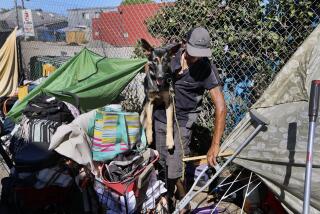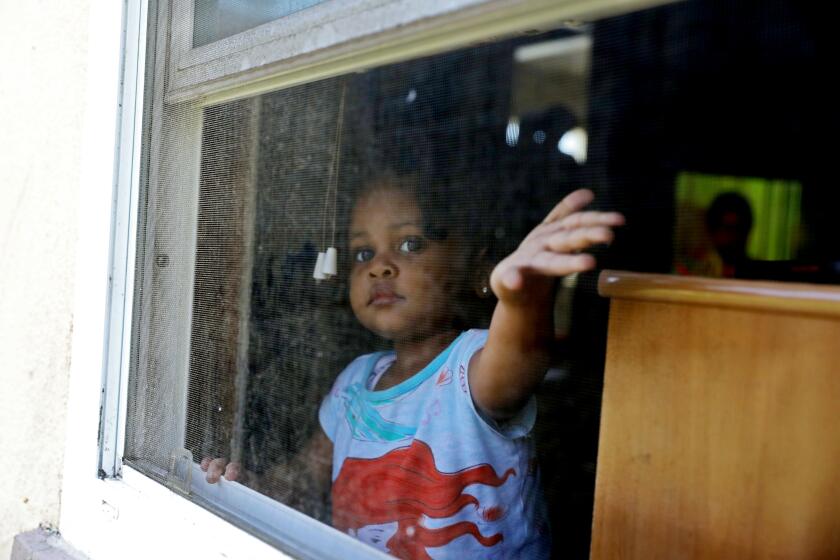The Homeless Define City’s True Self : Broken Promises on Skid Row Mock L.A.’s Boosterism
- Share via
The Los Angeles Police Department’s roundups of the homeless on Skid Row during the last month and the subsequent summit this week in response ought to draw attention to the city’s steady mistreatment of this sector of its population. The fact that the roundups will now stop does not mean that the problem has been solved.
It is a good thing that the roundup policy did not go unnoticed in the Los Angeles papers. But what has gotten lost along the way, as it almost always does with news from Skid Row, is the history of behavior behind the events: the behavior not only of the police but of city authorities -- their broken promises to the homeless in the downtown area.
I was present two years ago when the police swept through Skid Row streets, destroying the two dozen or so communities of cardboard boxes, tents and makeshift lean-to’s that the homeless had built. I cannot remember seeing a more sorrowful sight in America than what I witnessed during that destruction.
A crew of police officers moved through the dark, all but deserted streets. They went from community to community, ripping apart the tiny dwellings that had by then been abandoned by their builders. As each one was torn open, you could see, spotlighted by a trailing film crew, the suddenly exposed details of the meager and violated privacies of those who had lived inside. There were torn blankets, piles of rags, old clothes, dirty pillows, a few battered utensils or cups--the detritus of a privileged city out of which pauperized men and women had tried to create a semblance of normal life. Unceremoniously, efficiently, the city’s crew loaded it all into a truck headed for the dump.
The people who lived in those dwellings had abandoned them, in part, to avoid arrest. But there was another reason. Earlier that day there had been a meeting between city officials and the leaders of the homeless communities. An accord had been reached: If those living in the communities would leave them peacably, the city would agree to open a temporary encampment for the downtown homeless. In addition, city officials clearly indicated, if not promised, that the temporary camp would be kept open until a permanent site, which they were looking for, could be located .
Of course, that never happened. The temporary encampment ment--a huge dusty lot on Santa Fe Avenue, to which portable toilets and showers were brought and in which hundreds of people settled--remained open for a few months. Then, with no permanent replacement in sight, it was shut down to make room for an equipment yard for the new subway line.
I was there, too, the day the encampment was closed. Unlike the much publicized sweep of the street communities, it was not much of a media event. A couple of camera crews and journalists came and went, but the only concerned private citizen I saw was a black minister offering families help. Given the set-up of the camp, with its chain-link fence and two main gates, it would have taken only a dozen citizens linking arms (think of the thousands protesting our Nicaraguan policies, or the treatment of Jews in the Soviet Union) to protest or even stop, at least for a while, the forced displacement of the poor. But none were around to try it. The camps’ inhabitants filed out, some with children, into the downtown streets, shopping carts laden with what belongings they could carry.
That, too, was one of the sorrier sights I have seen.
As the homeless left the city’s encampment that day, an old man called out to me, mistaking me as homeless: “You gonna be alright, bro’?” Those words still echo in my mind like the refrain of a Depression song. But there is a difference between our own age and the Depression. Back then, when almost everyone was in trouble, shantytowns sprang up everywhere. But the poor were sometimes left alone, in part because those in power understood that when the community does not provide shelter and safety to its members, then they have a right to provide those things for themselves.
I have no doubt that many of the men and women who were recently rounded up were among those whose dwellings were destroyed in the streets, and who were driven from the official encampment.
No doubt we would all be better off with fewer people living on the street. But if people are forced to set up house there, it is largely the fault of city policy. Had city officials kept their promises to the homeless, no one would now have to round them up.
This is, the city’s newspapers have begun to trumpet, Los Angeles’ “golden age,” its time in the sun. But is it? Tell that to the men and women displaced by police from their dwellings and encampment. A golden age? Tell that to the poor rousted from their doorways. Those are the images--not the gleaming towers, the hip museums--through which the city’s nature is revealed. They are the mirrors in which we, not unlike Dorian Gray, can see the true identity of Los Angeles beneath its fashionable masks. It is not a pretty sight.
If anything needs cleaning up, it is not the streets. It is the behavior of the police, the indifference and dishonesty of public officials, and the moral passivity of all those citizens who silently allow, in their names, those without homes to be treated like beasts. The city still owes to the Skid Row homeless far more than it has been willing to give.
More to Read
Sign up for Essential California
The most important California stories and recommendations in your inbox every morning.
You may occasionally receive promotional content from the Los Angeles Times.






